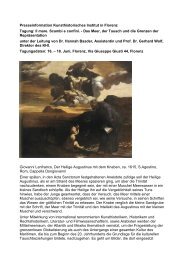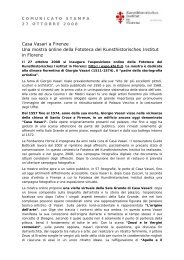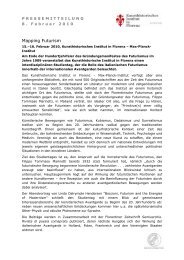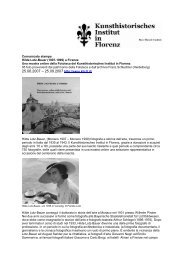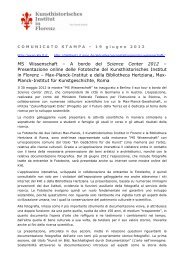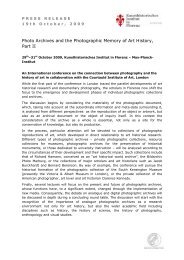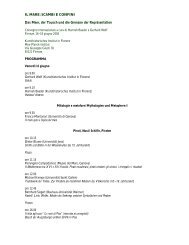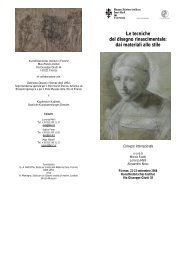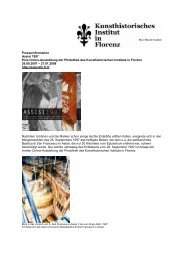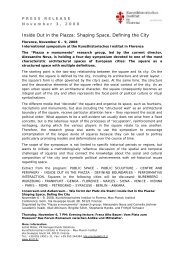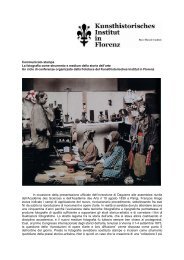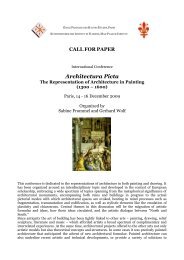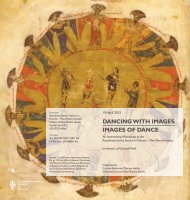Press Release - Kunsthistorisches Institut in Florenz
Press Release - Kunsthistorisches Institut in Florenz
Press Release - Kunsthistorisches Institut in Florenz
You also want an ePaper? Increase the reach of your titles
YUMPU automatically turns print PDFs into web optimized ePapers that Google loves.
PRESS RELEASE – 21 November 2011<br />
http://expo.khi.fi.it<br />
BARTOLOMEO AMMANNATI – An onl<strong>in</strong>e-exhibition by the Photo<br />
Library of the <strong>Kunsthistorisches</strong> <strong>Institut</strong> <strong>in</strong> <strong>Florenz</strong> – Max-<br />
Planck-<strong>Institut</strong><br />
The Photo Library of the <strong>Kunsthistorisches</strong> <strong>Institut</strong> <strong>in</strong> <strong>Florenz</strong> – Max-Planck-<br />
<strong>Institut</strong> is showcas<strong>in</strong>g its current photographic campaign of some important<br />
works of Bartolomeo Ammannati <strong>in</strong> an onl<strong>in</strong>e-exhibition.<br />
As part of preparations for the exhibition “L’acqua, la pietra, il fuoco. Bartolomeo<br />
Ammannati scultore”, which the Museo del Bargello <strong>in</strong> Florence was hold<strong>in</strong>g this year to<br />
mark the fifth th centenary of the artist’s birth, the Photo Library of the <strong>Kunsthistorisches</strong><br />
<strong>Institut</strong> <strong>in</strong> <strong>Florenz</strong> was <strong>in</strong>volved with a photographic campaign, which could be conducted<br />
under ideal conditions. With a view to a revamped museum display and a virtual<br />
reconstruction of Ammannati’s Fontana di Sala Grande, a few of his works were removed<br />
from the walls of the Bargello; this made it possible for the first time to photograph the<br />
sculptures <strong>in</strong> the round. The result<strong>in</strong>g photographic documentation provides researchers<br />
with a wholly new angle of vision of Ammannati’s sculptural works.<br />
From 21 November 2011 the Photo Library is show<strong>in</strong>g a total of 46 photos from this<br />
campaign <strong>in</strong> its new onl<strong>in</strong>e-exhibition. They are supplemented with 14 photos of the<br />
Palazzo Grifoni Bud<strong>in</strong>i Gattai, where the Photo Library is situated, and one of<br />
Ammannati’s ma<strong>in</strong> architectural works.<br />
Bartolomeo Ammannati (1511-1592) was one of the most important artists of the<br />
Florent<strong>in</strong>e High Renaissance. After an apprenticeship <strong>in</strong> the workshop of the sculptor<br />
Baccio Band<strong>in</strong>elli and periods of activity <strong>in</strong> Venice and Urb<strong>in</strong>o, he received his first major<br />
commission between 1540 and 1542: the tomb of Mario Nari <strong>in</strong> Santissima Annunziata.<br />
In 1550 Ammannati went to Rome, where he met Michelangelo, whose works he had<br />
already studied with great attention <strong>in</strong> Florence. His admiration for the age<strong>in</strong>g master,<br />
and the <strong>in</strong>fluence his work had on Ammannati’s sculptures, can be felt <strong>in</strong> all his works, as<br />
already <strong>in</strong> his “Leda with the Swan” dat<strong>in</strong>g to c.1536. What cannot be ignored <strong>in</strong> this<br />
sculpture is the stylistic, and also the iconographic, aff<strong>in</strong>ity with Michelangelo, who had<br />
developed this mythological theme <strong>in</strong> a now lost, but much copied pa<strong>in</strong>t<strong>in</strong>g for Alfonso<br />
d’Este between 1529 and 1530.<br />
Ammannati achieved his artistic breakthrough after his return to Florence from Rome <strong>in</strong><br />
1555. Cosimo I de‘ Medici had called him to his court, where, with the active support of<br />
Vasari and Michelangelo, he speedily rose to become one of the artists most <strong>in</strong> demand.<br />
Together with Vasari he worked on the transformation of the medieval Palazzo Vecchio<br />
<strong>in</strong>to a sumptuous ducal residence and designed a monumental founta<strong>in</strong> ensemble for the
Salone dei C<strong>in</strong>quecento between 1556 and 1561. Alterations <strong>in</strong> plan to do with the height<br />
of the ceil<strong>in</strong>g led to the project be<strong>in</strong>g abandoned. But the sculptures for it had already<br />
been completed. Some of them, such as the two peacocks flank<strong>in</strong>g Juno, the nymph<br />
Castalia and the personified river Arno, were <strong>in</strong>cluded <strong>in</strong> Ammannati’s founta<strong>in</strong> above the<br />
courtyard of the Palazzo Pitti <strong>in</strong> 1588-1589. They were then <strong>in</strong>stalled as garden-statues<br />
<strong>in</strong> the Boboli Gardens, before eventually be<strong>in</strong>g removed to the Bargello for conservational<br />
reasons. However, a 3-D model, specially developed <strong>in</strong> the context of the exhibition<br />
mark<strong>in</strong>g the sculptor’s fifth th centenary, provides a virtual reconstruction of Ammannati’s<br />
orig<strong>in</strong>al project.<br />
While Ammannati was still work<strong>in</strong>g on his founta<strong>in</strong> for the Salone dei C<strong>in</strong>quecento, he<br />
received further commissions from Cosimo I. They <strong>in</strong>cluded the bronze group of Hercules<br />
wrestl<strong>in</strong>g with the giant Antaeus (1559-1560). It was <strong>in</strong>tended for the founta<strong>in</strong> <strong>in</strong> the<br />
garden of the Villa Medici <strong>in</strong> Castello. It captures the turn<strong>in</strong>g po<strong>in</strong>t <strong>in</strong> the contest when<br />
Hercules powerfully grasps his arms round Antaeus’ chest and hoists him <strong>in</strong>to the air.<br />
A small but significant <strong>in</strong>sight <strong>in</strong>to the artist’s architectural works is provided lastly by the<br />
group of photos of the Palazzo Grifoni Bud<strong>in</strong>i Gattai <strong>in</strong> the Piazza Santissima Annunziata<br />
<strong>in</strong> Florence. Erected for Ugol<strong>in</strong>o Grifoni, secretary of Cosimo I, between 1561 and 1565,<br />
the Palazzo Grifoni is strik<strong>in</strong>g not only for its monumentality, but also for its use of red<br />
terracotta bricks, nuanced <strong>in</strong> their vary<strong>in</strong>g shades of russet and orange, which<br />
Ammannati consciously <strong>in</strong>corporated <strong>in</strong>to the articulation of the façade. When the Photo<br />
Library of the <strong>Kunsthistorisches</strong> <strong>Institut</strong> <strong>in</strong> <strong>Florenz</strong> conducted its photographic campaign<br />
<strong>in</strong> 2010, particular attention was paid to chang<strong>in</strong>g light<strong>in</strong>g conditions and their <strong>in</strong>fluence<br />
on the colour of the bricks as well as on the plastic effect of the build<strong>in</strong>g. So the façade<br />
was photographed at different times of the day to illustrate the architect’s sophisticated<br />
play with colour and texture.<br />
BARTOLOMEO AMMANNATI – An onl<strong>in</strong>e-exhibition by the Photo Library of the<br />
<strong>Kunsthistorisches</strong> <strong>Institut</strong> <strong>in</strong> <strong>Florenz</strong> – Max-Planck-<strong>Institut</strong><br />
Concept: Costanza Caraffa, Almut Goldhahn<br />
Texts: Almut Goldhahn<br />
Coord<strong>in</strong>ation and edit<strong>in</strong>g: Almut Goldhahn<br />
From 21 November onl<strong>in</strong>e on the website http://expo.khi.fi.it<br />
Further <strong>in</strong>fo:<br />
Dott.ssa Stefania Clio Lösch<br />
Head of Public Relations<br />
<strong>Kunsthistorisches</strong> <strong>Institut</strong> <strong>in</strong> <strong>Florenz</strong> - Max Planck <strong>Institut</strong><br />
Via Giuseppe Giusti 44, 50121 Firenze, Italia<br />
Tel. +39 055 249 11 90, Fax +39 055 244 394<br />
khi-presse@khi.fi.it<br />
www.khi.fi.it/<br />
PRESS RELEASE, 21 November 2011<br />
Bartolomeo Ammannati – An onl<strong>in</strong>e-exhibition by the Photo Library of the<br />
<strong>Kunsthistorisches</strong> <strong>Institut</strong> <strong>in</strong> <strong>Florenz</strong> – Max-Planck-<strong>Institut</strong>
PRESS RELEASE<br />
21 November 2011<br />
Images<br />
Bartlolomeo Ammannati,<br />
Recumbent figure of Mario<br />
Nari, 1540-42, Florence,<br />
Museo Nazionale del Bargello,<br />
marble, height: 67 cm,<br />
length: 159 cm, depth: 53 cm<br />
© <strong>Kunsthistorisches</strong> <strong>Institut</strong> <strong>in</strong><br />
<strong>Florenz</strong> - Max-Planck-<strong>Institut</strong><br />
Bartolomeo Ammannati, Leda<br />
and the Swan, around 1536,<br />
Florence, Museo Nazionale del<br />
Bargello, marble, height: 48<br />
cm, length: 70.5 cm, depth:<br />
33 cm © <strong>Kunsthistorisches</strong><br />
<strong>Institut</strong> <strong>in</strong> <strong>Florenz</strong> - Max-<br />
Planck-<strong>Institut</strong><br />
Bartolomeo Ammannati,<br />
Personification of the River<br />
Arno, 1556-61, marble,<br />
height: 230 cm ©<br />
<strong>Kunsthistorisches</strong> <strong>Institut</strong> <strong>in</strong><br />
<strong>Florenz</strong> - Max-Planck-<strong>Institut</strong>
Bartlolomeo Ammannati,<br />
Herkules and Antaeus, 1559-<br />
60, Florence, Museo Nazionale<br />
de Bargello, bronze, height:<br />
201 cm © <strong>Kunsthistorisches</strong><br />
<strong>Institut</strong> <strong>in</strong> <strong>Florenz</strong> - Max-<br />
Planck-<strong>Institut</strong><br />
Bartolomeo Ammannati,<br />
Herkules and Antaeus, detail:<br />
head of Antaeus, 1559-60,<br />
Florence, Museo Nazionale del<br />
Bargello, bronze, height: 201<br />
cm © <strong>Kunsthistorisches</strong><br />
<strong>Institut</strong> <strong>in</strong> <strong>Florenz</strong> - Max-<br />
Planck-<strong>Institut</strong><br />
Bartolomeo Ammannati,<br />
Palazzo Grifoni, 1561-65,<br />
Florence, Façade on the Piazza<br />
Santissima Annunziata ©<br />
<strong>Kunsthistorisches</strong> <strong>Institut</strong> <strong>in</strong><br />
<strong>Florenz</strong> - Max-Planck-<strong>Institut</strong><br />
PRESS RELEASE, 21 November 2011<br />
BARTOLOMEO AMMANNATI –<br />
An onl<strong>in</strong>e exhibition by the Photo Library of the <strong>Kunsthistorisches</strong> <strong>Institut</strong><br />
<strong>in</strong> <strong>Florenz</strong>–Max-Planck-<strong>Institut</strong>



